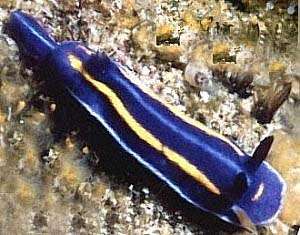
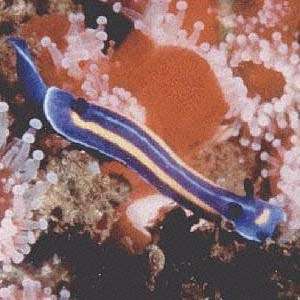
Mexichromis porterae
(Cockerell, 1902)
Order: NUDIBRANCHIA
Suborder: DORIDINA
Family: Chromodorididae
DISTRIBUTION
Eastern Pacific from Monterey Bay, California to Baja California, Mexico.
PHOTO
Both photos are from California's Channel Islands. PHOTO: Scott Johnson.
Mexichromis porterae is one of a number of blue chromodorids with yellow markings from the eastern Pacific. It is characterised by the thin white border to the mantle, a bluish white line down the dorsal midline and bright yellow line down each side of the mantle. The species it resembles most closely in colour is Chromodoris macfarlandi which has a violet background colour, a white border, and three yellow longitudinal lines. Another species, Hypselodoris californiensis, is dark blue with yellow spots. Grows to 35 mm in length (Behrens, 1991 )
-
Cockerell, T. D. A. (1902) Three new species of Chromodoris. The Nautilus, 16(2): 19-21.
Rudman, W.B., 1999 (January 16) Mexichromis porterae (Cockerell, 1902). [In] Sea Slug Forum. Australian Museum, Sydney. Available from http://www.seaslugforum.net/find/mexiport
Related messages
Mexichromis porterae from Laguna Beach, California
August 2, 2006
From: Kevin Lee

Hi Doc,
Here's a few fotos of Mexichromis porterae. As I was trying to photograph the nud, there was quite a bit of surge and it lifted up the mantle, revealing the underside of the critter and its oral tentacles (I'm guessing).
Locality: Deadman's Reef, Crescent Bay, Laguna Beach, 25fsw, California, USA, Eastern Pacific, 04 July 2006, rocky reef. Length: 2cm. Photographer: Kevin Lee.
Best wishes,
K:-)
diverkevin@gmail.com
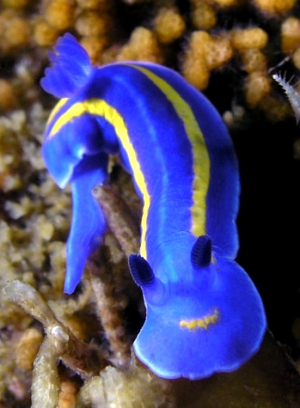
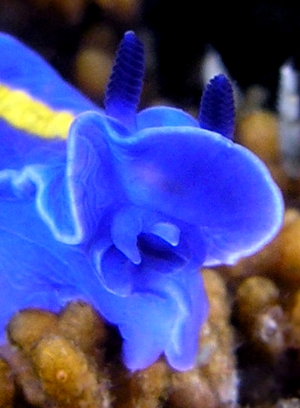
Dear Kevin,
Yes the flattened triangular shaped flaps are its oral tentacles. Most chromodorids have more tapering cylindrical tentacles, so this is an interesting observation. I don't think its a character of the genus Mexichromis however, because species I am familiar with from the Indo-West Pacific don't have this shaped oral tentacles. I guess its another thing to add to the 'to check up' list.
Best wishes,
Bill Rudman
Photo of Mexichromis porterae
July 4, 2006
From: Aidan Hampson
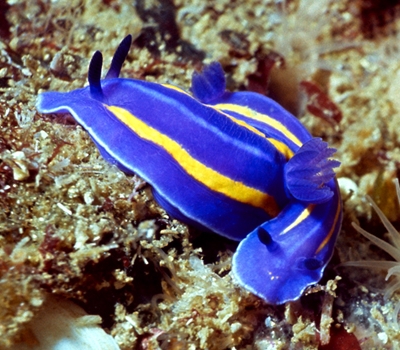
Hi,
I just got a great shot of a pair of Mexichromis porterae breeding and thought you might like a copy for the Sea Slug Forum.
Locality: Isthmus Reef, Santa Cantalina Island, 20 ft, CA USA, Pacific, 24 June 2006, rocky Kelp forest. Length: 30 mm. Photographer: Aidan Hampson. [Motor MarineIII with Macro, F16, Fuji Provia100 film]
Regards,
Aidan Hampson
seaspyder@cox.net
Hampson A.J., 2006 (Jul 4) Photo of Mexichromis porterae. [Message in] Sea Slug Forum. Australian Museum, Sydney. Available from http://www.seaslugforum.net/find/17045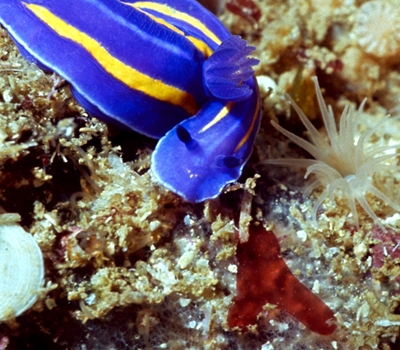
Dear Aidan,
Thanks very much for thinking of us. These animals have their reproductive organs on the right side of the body just behind the rhinophores, so from the way your two animals are aligned I suspect they are not actually mating. But I suspect their position is either pre- or postnuptial.
Another interesting thing in your photo is the bluish grey patch below the two nudibranchs. McDonald & Nybakken (1978) reported that this species feeds on the sponge Dysidea amblia, and this patch could well be a dysideid. I am sure one of out west coast colleagues can correct me if I am wrong. Some dysideids are often partially covered by sand grains or have them incorporated in their outer layers, which can make it very difficult to know if a chromodorid is feeding on a sponge or just crawling over a patch of sand. My guess is that these two animals are together because of the food sponge. That is not to say they won't mate - but to be totally unromantic, the initial attraction is the food, rather than the beauty of the nudibranchs.
-
McDonald, G.R. & Nybakken, J.W. 1978. Additional notes on the food of some California nudibranchs with a summary of known food habits of California species. The Veliger, 21(1): 110-118.
Best wishes,
Bill Rudman
More on Mexichromis porterae
July 29, 2005
From: Clinton Bauder
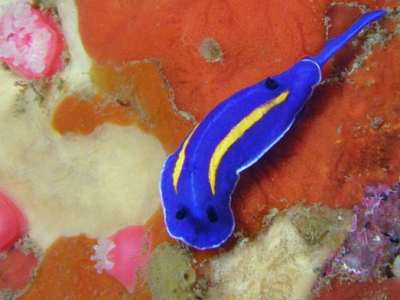
Hi Bill,
Since this species seems to be topical, here are a couple of images of Mexichromis porterae on a couple of different sponges from a deep dive in Carmel a few years back. Size was about 25 mm if I remember right. Depth maybe 50 meters. The larger image was taken by my friend Sami Laine, the smaller one is mine (from video).
Locality: Outer Pinnacles, Carmel, California, USA. Depth: 50 meters. Length: 25 mm.18 Jan 2003. Vertical wall. Photographer: Sami Laine, Clinton Bauder
Clinton
gecko1@apple.com
Bauder, C., 2005 (Jul 29) More on Mexichromis porterae . [Message in] Sea Slug Forum. Australian Museum, Sydney. Available from http://www.seaslugforum.net/find/14440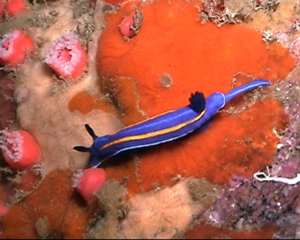
Thanks Clinton,
It's good when a topic stimulates some more messages. Your animal seems to be on a mixed assemblage of sponges, cnidarians and ascidians. Mexichromis porterae has been reported to feed on a species of Dysidea, but as luck would have it I can't see anything looking like Dysidea in your photos. Some chromodorids seem to always be found with their food while others are seldom seen near anything identifiable.
Best wishes,
Bill Rudman
Mexichromis porterae from California
July 28, 2005
From: Chris Grossman
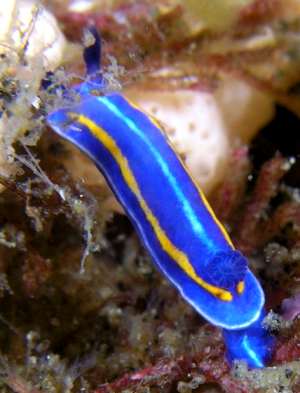
I took these images of Mexichromis porterae at East End Reserve of Anacapa Island, California, USA on July 16, 2005. The depth was about 12 meters. The specimen was about 1.5 cm in length.
Locality: East End Reserve of Anacapa Island, California, USA. Depth: 12 meters. Length: 1.5 cm. July 16, 2005. rocky with kelp. Photographer: Chris Grossman
All of the photos from that dive trip can be found here:
californiadiveboats.com/Peace/2005.07.15-16/
Chris Grossman
seaslugforum.net@scubadiversnetwork.com
Grossman, P. C., 2005 (Jul 28) Mexichromis porterae from California. [Message in] Sea Slug Forum. Australian Museum, Sydney. Available from http://www.seaslugforum.net/find/14431Dear Chris,
Thanks for another photo of this species. It is nice for you to be able to compare it with the very similarly coloured Chromodoris macfarlandi at the same time [see message #14430 ]. If you ever catch it on its food sponge or laying eggs, photos would be very welcome
Best wishes,
Bill Rudman
Photos of Mexichromis porterae
July 26, 2005
From: Amber Thweatt
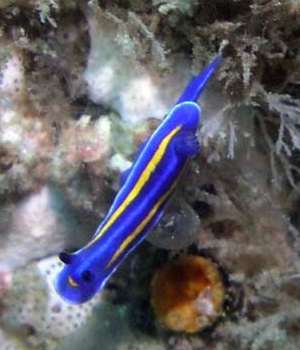
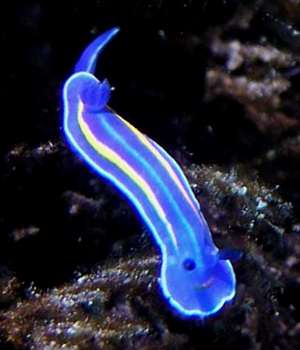
I've been reading seaslugforum for quite some time now, and until today I've never posted anything. I am also addicted to taking seaslug photos. I was very excited on Saturday during a dive at Catalina Island to have my first sighting of a Mexichromis porterae. I think they've been alluding me because I didn't realized how small they were. This particular species was about 1-1.5 cm in length. I thought you might enjoy seeing the photos.
Locality: Catalina Island (Dead Man's Reef), California, USA. Depth: 30 feet. Length: 1 cm. 23 July 2005. Kelp Reef. Photographer: Amber Thweatt
Amber
seaslugchick@cox.net
Thweat, A., 2005 (Jul 26) Photos of Mexichromis porterae. [Message in] Sea Slug Forum. Australian Museum, Sydney. Available from http://www.seaslugforum.net/find/14420Dear Amber,
What a spectacular way to make a debut on the Forum! It is indeed a beautiful animal. Sorry I didn't have a size indication on the Fact Sheet - which I have now added. Dave Behrens (1991) notes that it grows to 35 mm in length
Best wishes,
Bill Rudman
Mexichromis porterae mating
August 4, 2004
From: Chris Grossman
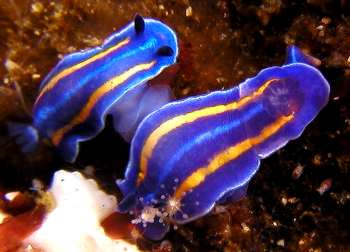
Bill,
Here is a photo of Mexichromis porterae mating which I took last Friday, July 16, 2004, while diving at Sutil Island, just off Santa Barbara Island, California.
Chris Grossman
chris@diver.net
Grossman, C., 2004 (Aug 4) Mexichromis porterae mating. [Message in] Sea Slug Forum. Australian Museum, Sydney. Available from http://www.seaslugforum.net/find/12727Thanks Chris,
It's nice to get photos of this species which is so similar in colour to Chromodoris macfarlandi and Hypselodoris californiensis. We have a group of red-spotted chromodorids in southeastern Australia. All chromodorids have noxious glands in their skin and we think these groups of similarly coloured species have evolved because it is easier for fish predators to learn to avoid just one colour pattern.
Best wishes,
Bill Rudman
Thank you
December 8, 1999
From: Lacey Keen
Dear Dr. Rudman,
I just wanted to thank you for your help with Mexichromis porterae. I asked you for some info for a biology project and your information really helped. I ended up getting a perfect score and owe it to you! I will continue to look at your site even though the project is over, the pictures alone are worth the time.
Thanks again,
Lacey Keen
keenl@meredith.edu
Keen, L., 1999 (Dec 8) Thank you. [Message in] Sea Slug Forum. Australian Museum, Sydney. Available from http://www.seaslugforum.net/find/1654Dear Lacey,
Great news on your project. Thanks for letting me know how it went.
Best wishes,
Bill Rudman.
Another Mexichromis porterae query
November 9, 1999
From: beth
hi. I'm a student at meredith college and i'm doing a research project on Chromodoris porterae and i'm having trouble finding the specific information that i need. i was wondering if you could help me find out more about it. i need to know how it feeds, what it's nutritional requirements are, it's general habitat, it's general distribution around the world, and it's ecological importance. any information would greatly appreciated.
beth
scottb@meredith.edu
Dear Beth,
Have a look at the answer I gave to Lacey Keen, a classmate of yours, a few days ago, to the same question.
best wishes,
Bill Rudman.
Information on Mexichromis porterae
November 4, 1999
From: Lacey Keen
Dr. Rudman,
I am a college student, and for our biology project have to do an organism description on Chromodoris porterae. I have found many things about the genus but have found very little on this specific species. So if you know any specific knowledge on it particularly I would appreciate it (habitat, nutrition, etc.) Also I have had a hard time answering the question of ecology and how Nudibranchs fit into their surroundings (What is it's place in the biosphere. Any help is much appreciated for it is due soon and I have a ways to go!
Thanks-
Lacey
keenl@meredith. edu
Dear Lacey,
You're lucky that Mexichromis porterae is one of the few Californian nudibranchs I have a picture of on the Forum. Like many nudibranchs, I don't think a lot has been published on its biology and natural history. One important point for you to know though is that for the last 20 years it has been placed in the genus Mexichromis, rather then Chromodoris, because parts of its anatomy (eg: radular teeth, reproductive system)are rather different from those found in species of Chromodoris.
Like all chromodorids, Mexichromis porterae is a sponge feeder, and has been reported by a number of authors to feed on the sponge Dysidea amblia DeLaubenfels. Chromodorids, like Mexichromis, have some very interesting defence mechanisms. Like many plants, sponges make and store in their tissues, a variety of distasteful chemicals to deter animals from eating them. Sponge-feeding chromodorids are not affected by these chemicals and remove them from the sponges they eat, and store them in glands around the edge of their mantle. In combination with their bright colour patterns, predators, such as fish, apparently learn that these nudibranchs taste terrible and aren't worth eating. Have a look at the pages on Defensive Glands, and Mexichromis macropus. Also have a look at the section on 'Warning Display' in the Defence - Colour Patterns Page. Mexichromis porterae is one of a number of species on the west coast of America with a blue and yellow colour pattern, suggesting a mimicry group like the red-spotted chromodorids of south-eastern Australia. Have a look at Mike Miller's messages illustrating some of these West Coast animals - though I think they are all yellow spotted rather than yellow-lined. I guess you are familar with Dave Behren's book Pacific Coast Nudibranchs which will also give you some background information. All I can find in the literature on other aspects of their natural history is that they are fairly uncommon and found from the intertidal to about 18m depth. Perhaps someone with further information will let us know. For example does anyone know if they have free-swimming veliger larvae or direct development?
About the last part of your essay topic What is it's place in the biosphere?. It's not possible to answer such a question. To me it suggests there is some plan to nature and the environment, which is wrong. Evolution is directionless and without a plan. That's how it works. Nudibranchs don't have a 'place' or a 'purpose' they just 'are'.
Closely related species have their own food requirements and possibly other slight differences in ecology. However, because at any one place, the actual species present, and their numbers, can change over time, the inter-relationships between species is continually changing. You can say that Mexichromis porterae has a direct predator-prey relationship with the sponge Dysidea amblia but every other relationship it has with the fauna and flora at that place is in a continual state of flux. Sorry there is no easy answer to life's big questions.
Good luck with your assignment,
Bill Rudman.
Mexichromis from California
January 22, 1999
From: Scott Johnson


Hi Bill
Here are 2 shots of Mexichromis porterae to add to your Mexichromis spp. The scans are kind of low resolution, and you may have to fiddle with the contrast for best color. Both were shot off California's Channel Islands.
Scott
johnson@kmrmail.kmr.ll.mit.edu
Johnson, S., 1999 (Jan 22) Mexichromis from California. [Message in] Sea Slug Forum. Australian Museum, Sydney. Available from http://www.seaslugforum.net/find/505Thanks Scott,
It's quite a coincidence that your photos have arrived at the same time as I am posting Roberto Moresco's photos of Hypselodoris messinensis from the Mediterranean, where, as I am sure you know, there is another, somewhat bigger collection of blue chromodorids with yellow markings. It's good to hear from you.
Best wishes,
Bill Rudman.
